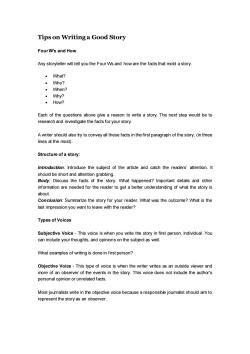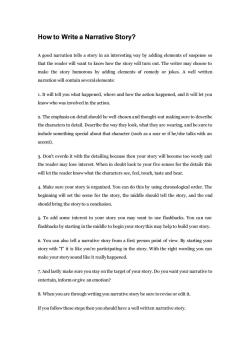《新编大学英语》综合教程(第三版第一册)B1U1_self market_Writing Material_How to Write a Narrative Story

Tips on Writing a Good Story FourWs and How Any storyteller will tell you the Four Ws and how are the facts that mold a story. ·hat? ·ho? When? ·hy? ·How? Each of the questions above give a reason to write a story.The next step would be to research and investigate the facts for your story. A writer should also try to convey all these facts in the first paragraph of the story,(in three lines at the most). Structure of a story: Introduction:Introduce the subject of the article and catch the readers'attention.It should be short and attention grabbing. Body:Discuss the facts of the story.What happened?Important details and other information are needed for the reader to get a better understanding of what the story is about. Conclusion:Summarize the story for your reader.What was the outcome?What is the last impression you want to leave with the reader? Types of Voices Subjective Voice-This voice is when you write the story in first person,individual.You can include your thoughts,and opinions on the subject as well. What examples of writing is done in first person? Objective Voice-This type of voice is when the writer writes as an outside viewer and more of an observer of the events in the story.This voice does not include the author's personal opinion or unrelated facts. Most journalists write in the objective voice because a responsible joumalist should aim to represent the story as an observer
Tips on Writing a Good Story Four W's and How Any storyteller will tell you the Four Ws and how are the facts that mold a story. • What? • Who? • When? • Why? • How? Each of the questions above give a reason to write a story. The next step would be to research and investigate the facts for your story. A writer should also try to convey all these facts in the first paragraph of the story, (in three lines at the most). Structure of a story: Introduction: Introduce the subject of the article and catch the readers’ attention. It should be short and attention grabbing. Body: Discuss the facts of the story. What happened? Important details and other information are needed for the reader to get a better understanding of what the story is about. Conclusion: Summarize the story for your reader. What was the outcome? What is the last impression you want to leave with the reader? Types of Voices Subjective Voice - This voice is when you write the story in first person, individual. You can include your thoughts, and opinions on the subject as well. What examples of writing is done in first person? Objective Voice - This type of voice is when the writer writes as an outside viewer and more of an observer of the events in the story. This voice does not include the author's personal opinion or unrelated facts. Most journalists write in the objective voice because a responsible journalist should aim to represent the story as an observer

How to Write a Narrative Story? A good narration tells a story in an interesting way by adding elements of suspense so that the reader will want to know how the story will turn out.The writer may choose to make the story humorous by adding elements of comedy or jokes.A well written narration will contain several elements: 1.It will tell you what happened,where and how the action happened,and it will let you know who was involved in the action. 2.The emphasis on detail should be well chosen and thought-out making sure to describe the characters in detail.Describe the way they look,what they are wearing,and be sure to include something special about that character(such as a scar or if he/she talks with an accent) 3.Don't overdo it with the detailing because then your story will become too wordy and the reader may lose interest.When in doubt look to your five senses for the details this will let the reader know what the characters see,feel,touch,taste and hear. 4.Make sure your story is organized.You can do this by using chronological order.The beginning will set the scene for the story,the middle should tell the story,and the end should bring the story to a conclusion. 5.To add some interest to your story you may want to use flashbacks.You can use flashbacks by starting in the middle to begin your story this may help to build your story. 6.You can also tell a narrative story from a first person point of view.By starting your story with"I"it is like you're participating in the story.With the right wording you can make your story sound like it really happened. 7.And lastly make sure you stay on the target of your story.Do you want your narrative to entertain,inform or give an emotion? 8.When you are through writing you narrative story be sure to revise or edit it. If you follow these steps then you should have a well written narrative story
How to Write a Narrative Story? A good narration tells a story in an interesting way by adding elements of suspense so that the reader will want to know how the story will turn out. The writer may choose to make the story humorous by adding elements of comedy or jokes. A well written narration will contain several elements: 1. It will tell you what happened, where and how the action happened, and it will let you know who was involved in the action. 2. The emphasis on detail should be well chosen and thought-out making sure to describe the characters in detail. Describe the way they look, what they are wearing, and be sure to include something special about that character (such as a scar or if he/she talks with an accent). 3. Don't overdo it with the detailing because then your story will become too wordy and the reader may lose interest. When in doubt look to your five senses for the details this will let the reader know what the characters see, feel, touch, taste and hear. 4. Make sure your story is organized. You can do this by using chronological order. The beginning will set the scene for the story, the middle should tell the story, and the end should bring the story to a conclusion. 5. To add some interest to your story you may want to use flashbacks. You can use flashbacks by starting in the middle to begin your story this may help to build your story. 6. You can also tell a narrative story from a first person point of view. By starting your story with "I" it is like you're participating in the story. With the right wording you can make your story sound like it really happened. 7. And lastly make sure you stay on the target of your story. Do you want your narrative to entertain, inform or give an emotion? 8. When you are through writing you narrative story be sure to revise or edit it. If you follow these steps then you should have a well written narrative story
按次数下载不扣除下载券;
注册用户24小时内重复下载只扣除一次;
顺序:VIP每日次数-->可用次数-->下载券;
- 《新编大学英语》综合教程(第三版第一册)B1U1_self market_Writing Material_All About People.doc
- 《新编大学英语》综合教程(第三版第一册)B1U1_self market_U1 Reading Material_一册第一单元 课文背景材料.doc
- 《新编大学英语》综合教程(第三版第一册)B1U1_self market_U1 Reading Material_一册一单元 课文翻译及课后练习答案.doc
- 《新编大学英语》综合教程(第三版第一册)B1U1_self market_U1 Reading Material_The Key to Harmonious Relationships.doc
- 《新编大学英语》综合教程(第三版第一册)B1U1_self market_U1 Reading Material_A Friend....doc
- 《新编大学英语》综合教程(第三版第一册)B1U1_self market_U1 Reading Material_A Friend in Need Is a Friend Indeed.doc
- 《新编大学英语》综合教程(第三版第一册)B1U1_self market_U1 Reading Material_5 Ways to Pick Friends Wisely.doc
- 《新编大学英语》综合教程(第三版第一册)B1U1_self market_U1 Reading Material_5 Ways to Build Better Relationships With Everyone.doc
- 《新编大学英语》综合教程(第三版第一册)B1U1_self market_B1U01 QUIZ_B1U01 Written Quiz.doc
- 《新编大学英语》综合教程(第三版第一册)B1U1_self market_B1U01 QUIZ_B1U01 Oral Quiz.ppt
- 《新编大学英语》综合教程(第三版第一册)B1U1_Read by critical thinking.ppt
- 《新编大学英语》综合教程(第三版第一册)B1U1_Menu.ppt
- 《新编大学英语》综合教程(第三版第一册)B1U1_Activate.ppt
- 《新编大学英语》翻译教学课件(PPT讲稿,第三版第四册,Translation and Writing)Lecture 10 文化与翻译2/2.ppt
- 《新编大学英语》翻译教学课件(PPT讲稿,第三版第四册,Translation and Writing)Lecture 10 文化与翻译1/2.ppt
- 《新编大学英语》翻译教学课件(PPT讲稿,第三版第四册,Translation and Writing)Lecture 09 科技英语的翻译(2)科技文体的句法特点与翻译方法2/2.ppt
- 《新编大学英语》翻译教学课件(PPT讲稿,第三版第四册,Translation and Writing)Lecture 09 科技英语的翻译(2)科技文体的句法特点与翻译方法1/2.ppt
- 《新编大学英语》翻译教学课件(PPT讲稿,第三版第四册,Translation and Writing)Lecture 08 科技英语的翻译(1)科技文体的词法特点与翻译方法2/2.ppt
- 《新编大学英语》翻译教学课件(PPT讲稿,第三版第四册,Translation and Writing)Lecture 08 科技英语的翻译(1)科技文体的词法特点与翻译方法1/2.ppt
- 《新编大学英语》翻译教学课件(PPT讲稿,第三版第四册,Translation and Writing)Lecture 07 句子成分的转换2/2.ppt
- 《新编大学英语》综合教程(第三版第一册)B1U1_Translation & Writing.ppt
- 《新编大学英语》综合教程(第三版第一册)B1U1_管鲍之交.doc
- 《新编大学英语》综合教程(第三版第一册)B1U2_Activate.ppt
- 《新编大学英语》综合教程(第三版第一册)B1U2_Menu.ppt
- 《新编大学英语》综合教程(第三版第一册)B1U2_Read by critical thinking.ppt
- 《新编大学英语》综合教程(第三版第一册)B1U2_self market_Reading Material_How To Improve Memory.doc
- 《新编大学英语》综合教程(第三版第一册)B1U2_self market_Reading Material_Memento Transcripts.doc
- 《新编大学英语》综合教程(第三版第一册)B1U2_self market_Reading Material_Memory Improvement.doc
- 《新编大学英语》综合教程(第三版第一册)B1U2_self market_Reading Material_My Personal Experience——-A Funny Memory.doc
- 《新编大学英语》综合教程(第三版第一册)B1U2_self market_Reading Material_Remember Me When I am Gone Away.doc
- 《新编大学英语》综合教程(第三版第一册)B1U2_self market_Reading Material_课文翻译及课后练习答案.doc
- 《新编大学英语》综合教程(第三版第一册)B1U2_self market_Reading Material_课文背景材料.doc
- 《新编大学英语》综合教程(第三版第一册)B1U2_self market_U2B1 QUIZ_06 B2U01 Oral Quiz.ppt
- 《新编大学英语》综合教程(第三版第一册)B1U2_self market_U2B1 QUIZ_Written Quiz_written quiz.doc
- 《新编大学英语》综合教程(第三版第一册)B1U2_self market_Writing Material_How to Write a Personal Experience.doc
- 《新编大学英语》综合教程(第三版第一册)B1U2_Translation & Writing.ppt
- 《新编大学英语》综合教程(第三版第一册)B1U3_English body language.doc
- 《新编大学英语》综合教程(第三版第一册)B1U3_self-market_Grammar and Vocabulary.doc
- 《新编大学英语》综合教程(第三版第一册)B1U3_self-market_Listening Material_How to Help Your Baby Learn to Talk Try Talking to Your Baby.doc
- 《新编大学英语》综合教程(第三版第一册)B1U3_self-market_QUIZ_Oral Quiz.ppt
